Naval Action photos of the Guadalcanal Campaign
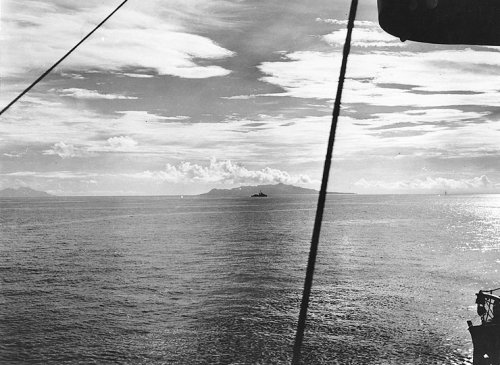
A U.S. destroyer steams up what later became known as
"Iron Bottom Sound",
the body of water between Guadalcanal and Tulagi, during landings on both islands,
7 August 1942.
Savo Island is in the center distance and Cape Esperance, on Guadalcanal, is at the left.
Photographed from USS San Juan (CL-54) from a location approximately due east
from the northern tip of Savo Island.
Official U.S. Navy Photograph, now in the collections of the
National Archives.
(info and text from the Naval Historical Center website)
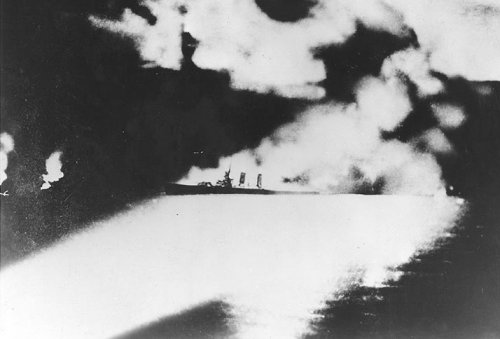
USS Quincy (CA-39)
Photographed from a Japanese cruiser during the Battle of Savo Island, off Guadalcanal, 9
August 1942.
Quincy, seen here burning and illuminated by Japanese searchlights, was sunk in
this action.
U.S. Naval Historical Center Photograph
(info and text from the Naval Historical Center website)
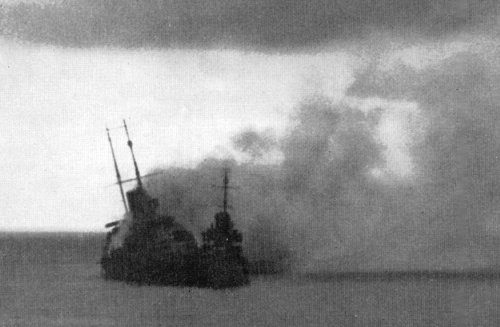
HMAS Canberra burns
The Australian cruiser Canberra (left), crushed by a Japanese hail of shells and
hit by two torpedoes,
is abandoned. The American destroyer Patterson (right), rescues the
remaining personnel.
(info and text from United States Destroyer Operations in World
War II by Theodore Roscoe, 1953 edition)
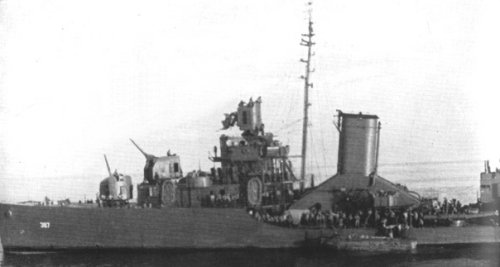
Havoc's aftermath
Survivors of the Canberra are transferred by the Blue, one of the
assisting destroyers, to the USS Melville.
(info and text from United States Destroyer Operations in World
War II by Theodore Roscoe, 1953 edition)
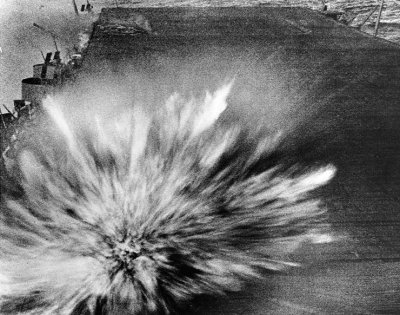
A Japanese bomb exploding on the flight deck of USS
Enterprise (CV-6), just aft of the island,
during the Battle of the Eastern Solomons on 24 August 1942.
Official U.S. Navy Photograph, now in the collections of the
National Archives.
(info and text from the Naval Historical Center website)
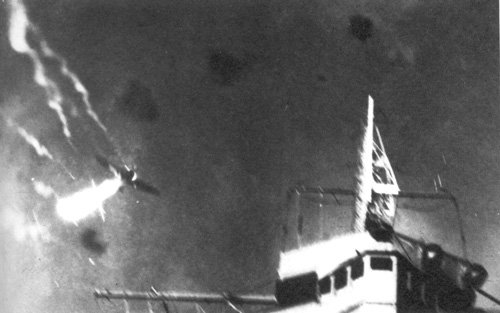
A Japanese Val dive bomber bursts into flames over Enterprise's
radar mast
during the Battle of the Eastern Solomons on 24 August 1942.
Official U.S. Navy Photograph
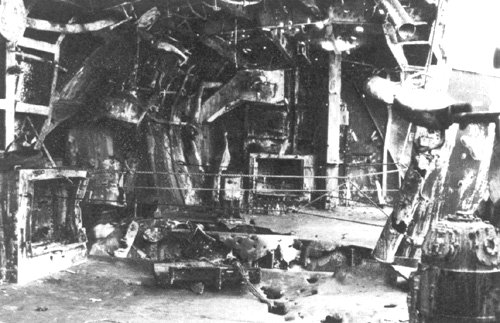
Effects of the bomb that wiped out Enterprise's
Gun Group 3.
Official U.S. Navy Photograph
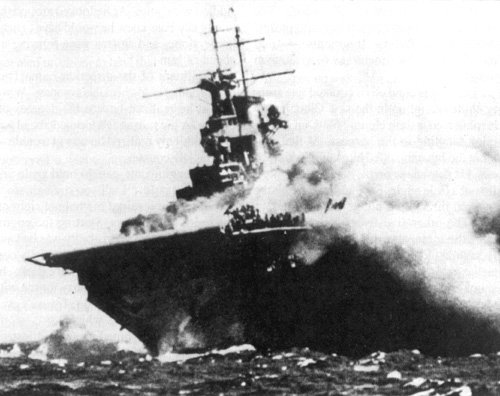
The American aircraft carrier USS Wasp burns
after being torpedoed by a Japanese submarine on
September 16, 1942, while operating some 150 miles southeast of San Cristobal
Island.
(source: Air Classics magazine, May 1990)
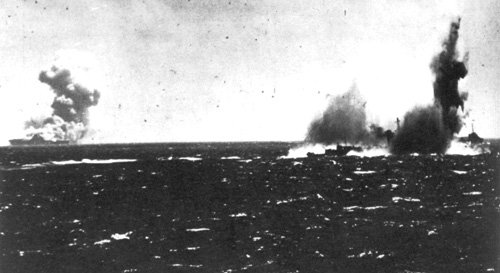
As the carrier USS Wasp burns in the background
(left) the destroyer USS O'Brien is struck by a torpedo fired by the Japanese
submarine I-19.
Official U.S. Navy Photograph
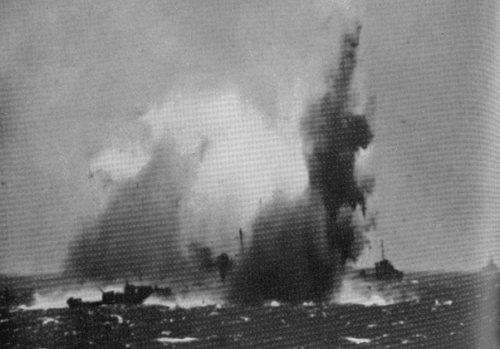
A close-up of the torpedo hit on the stern of the USS
O'Brien. The battleship North Carolina was also hit by the same sub.
Despite this attack and the loss of the Wasp, the convoy of US Marines and aviation
gasoline safely reached Guadalcanal's shores.
(info and text from United States Destroyer Operations in World
War II by Theodore Roscoe, 1953 edition)
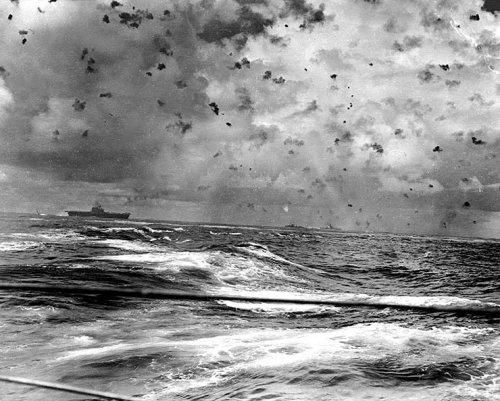
Battle of the Santa Cruz Islands, October 26 1942
U.S. Navy ships firing at attacking Japanese carrier aircraft during the battle, 26
October 1942. USS Enterprise (CV-6) is at left, with at least two enemy planes
visible overhead. In the right center is USS South Dakota, firing her starboard
5"/38 secondary battery, as marked by the bright flash amidships.
Official U.S. Navy Photograph, now in the collections of the
National Archives.
(info and text from the Naval Historical Center website)

The Mahan, right, and another destroyer are
shown steaming at high speed during the Santa Cruz action. Battle manuevering often is
difficult and dangerous. In this picture there is no collision course. However, shortly
after this action the Mahan collided with the South Dakota as a result
of a submarine alarm disrupting the force's formation. Both warships received damage.
(info and text from United States Destroyer Operations in World War II
by Theodore Roscoe, 1953 edition)
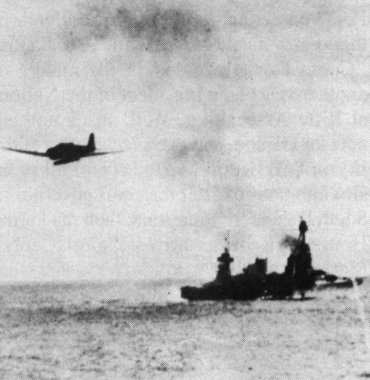
Japanese Kate torpedo bomber ready to drop its torpedo
at the Battle of the Santa Cruz
(source: Air Classics magazine, May 1990)
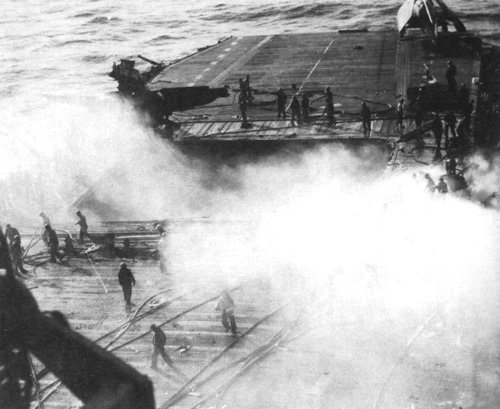
Firefighters manhandle long fire hoses on the deck of
the USS Enterprise, and damage control efforts
are in full swing. Smoke is pouring out of the forward elevator well following the
Japanese attack.
Official U.S. Navy Photograph
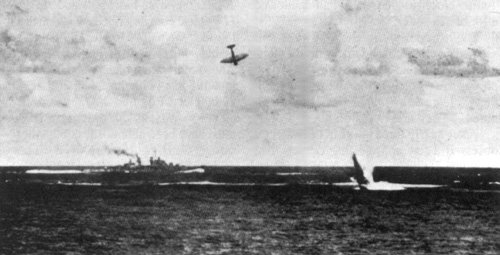
Japanese Val dive bomber about to crash into the water
at the Battle of the Santa Cruz.
Another Japanese aircraft has just hit the water to the right of the Val.
(source: Air Classics magazine, May 1990)
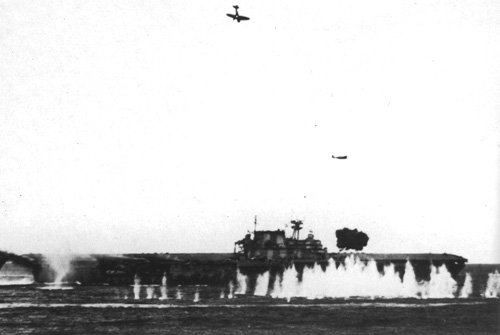
A Japanese Val dive bomber plummets toward the USS
Hornet's superstructure. The carrier is already
burning from several bomb hits. In the background a Japanese Kate torpedo bomber
flys past.
Official U.S. Navy Photograph
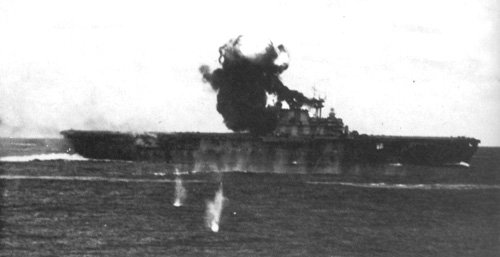
Moments after the above photo, the Val has impacted on
the Hornet's bridge.
Official U.S. Navy Photograph
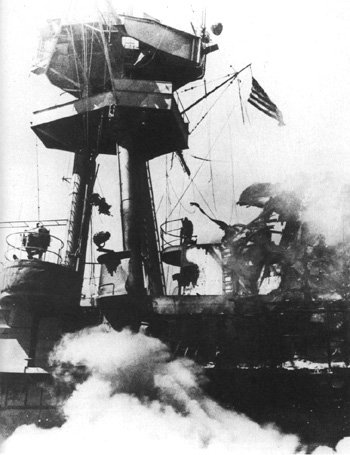
The shattered signal bridge of the USS Hornet.
Official U.S. Navy Photograph
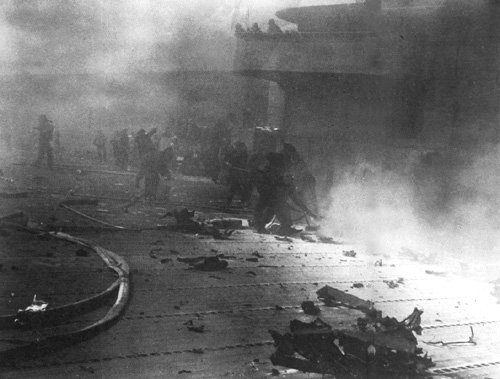
Fire fighters on the Hornet try to extinguish
the flames ignited from the flaming
gasoline spread by the crashed Val (parts of which are strewn across the deck).
Official U.S. Navy Photograph
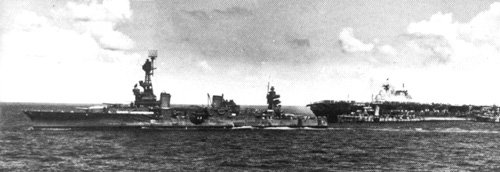
The American cruiser USS Northampton prepares
to pass a tow line to the striken carrier Hornet.
A pair of destroyers stay near the Hornet so their crews can help fight
her fires.
Official U.S. Navy Photograph

Our final large carrier loss of the war. USS Hornet
sinks in the Santa Cruz action. Her remarkable hull toughness absorbed many enemy torpedo,
bomb, and suicide plane hits and American torpedo and gunfire scuttling attempts. Four
Japanese torpedoes finally destroyed her. Here the USS Russell leads other
American destroyers to the work of damage control, fire-fighting and rescue.
(info and text from United States Destroyer Operations in World
War II by Theodore Roscoe, 1953 edition)
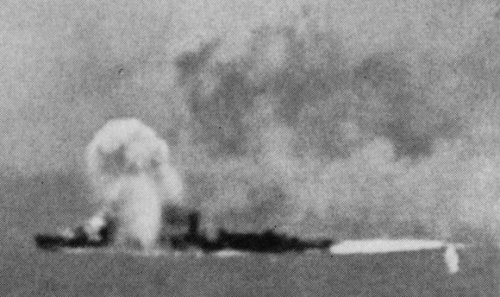
A Japanese Kate torpedo bomber crashes into the Smith's
forecastle during the Battle of Santa Cruz.
As the war progressed, the Japanese increasingly used these suicide tactics.
(info and text from United States Destroyer Operations in World
War II by Theodore Roscoe, 1953 edition)
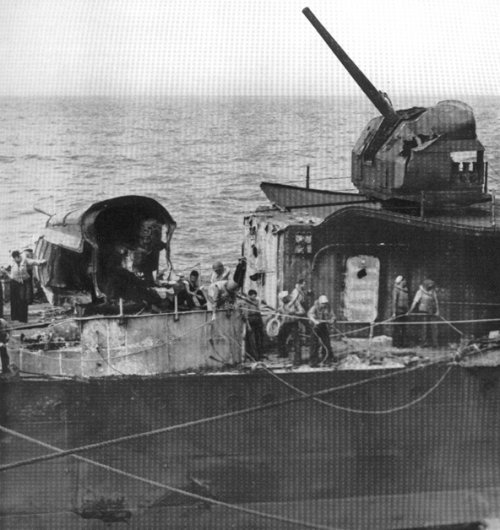
A picture taken after the Battle of Santa Cruz shows the
damage to the forward gun mounts and forecastle of USS Smith done by a Jap
suicide plane. With forecastle and bridge an inferno, the Smith's captain,
conning from aft, pushed her nose into the foaming wake of the battleship South Dakota.
The foam and spray cooled the flames, allowed fire-fighters to finish the job.
(info and text from United States Destroyer Operations in World
War II by Theodore Roscoe, 1953 edition)
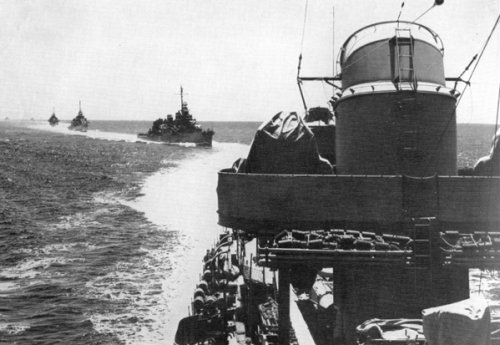
Task Force 67 just before the Battle of Tassafaronga. USS
Fletcher is in the foreground, followed by other destroyers and, in the distance,
cruisers. At Tassafaronga, Japanese Admiral Tanaka's destroyers gave us a lesson in
torpedo skill. Our destroyer-cruiser tactics had not been advanced in peace to meet war
exigencies of high-speed, limited-area surface night attacks.
(info and text from United States Destroyer Operations in World
War II by Theodore Roscoe, 1953 edition)
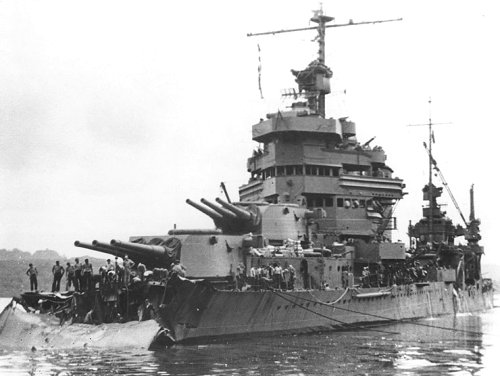
USS Minneapolis (CA-36)
USS Minneapolis (CA-36) at Tulagi with torpedo damage received in the
Battle of Tassafaronga, 30 November 1942.
Photograph was taken on 1 December 1942, as work began to cut away the wreckage of her
bow.
Official U.S. Navy Photograph, now in the collections of the
National Archives.
(info and text from the Naval Historical Center website)
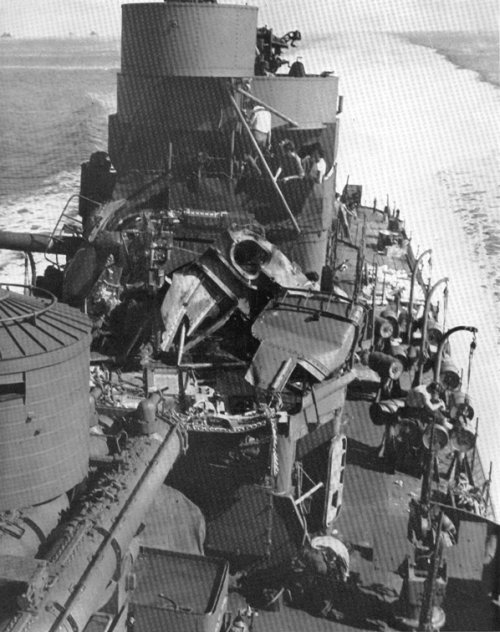
The last damaged American destroyer of the Guadalcanal
campaign. The Nicholas, above, suffered from enemy near misses and an accident.
Japanese dive-bombers swooped down in an attack on this warship, which had no fighter
cover, and damaged her steering gear. During the action, one 5-inch mount was wrecked, as
shown, by a hang-fire. Even an enemy shell might have done less harm.
(info and text from United States Destroyer Operations in World
War II by Theodore Roscoe, 1953 edition)
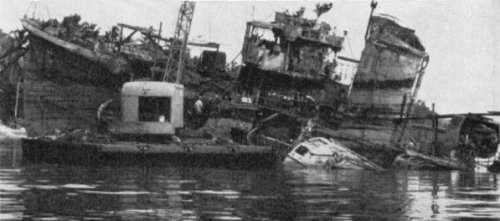
One of the dozen enemy destroyers that the US sank off
of Guadalcanal. Salvage attempts were soon abandoned.
Although the US lost more major combatant craft than the Japanese, it won the
logistics race.
(info and text from United States Destroyer Operations in World
War II by Theodore Roscoe, 1953 edition)
BACK TO PHOTO GALLERY
INDEX
Click here if navigation bar is not visible at the top




